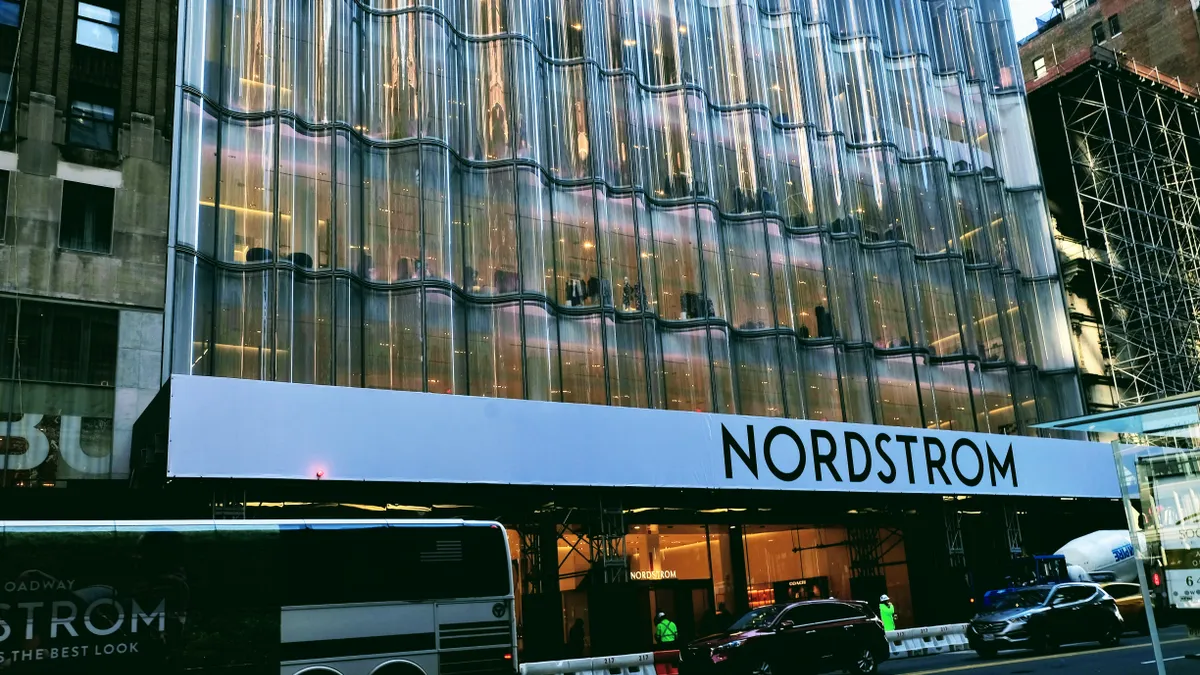Dive Brief:
-
Nordstrom beat expectations for its second quarter, but failed to achieve the improvements over 2019 seen at other department stores. Total company net sales rose 101% year over year but fell 6% from 2019, according to a filing with the Securities and Exchange Commission.
-
Digital sales rose 30% year over year and 24% from 2019, and were 40% of total sales. At Nordstrom, net sales rose 127% year over year and fell 5% versus 2019; at off-price Rack, net sales rose 61% year over year and fell 8% versus 2019. The company stopped reporting store comps pre-pandemic.
-
Nordstrom swung into the black with net income of $80 million from its $255 million net loss last year.
Dive Insight:
Like so many retailers, Nordstrom is making a comeback after a 2020 dominated by the COVID-19 pandemic, when stores were temporarily closed for weeks and both demand and supply were disrupted.
Supply continues to be an issue, CEO Erik Nordstrom told analysts Tuesday. In the second quarter, ending inventory was up 13% on a two-year basis, mostly because part of Nordstrom's Anniversary Sale took place the following quarter, and due to efforts to "mitigate continuing supply chain backlogs and support improving sales trends," per the release.
"We have seen real lumpiness in the global supply chain that has led to some shortages. And more so, just unevenness. It's been difficult to plan inventory flow with much precision," Erik Nordstrom said, according to a transcript from Motley Fool, adding that's unlikely to change any time soon. "So, truly, I'm asked to find ways of mitigating that. So, we've done things like pulling forward orders, expanding lead times. We are looking to strategically use some airfreight for holiday."
Chief Financial Officer Anne Bramman said the company expects inventory to be "pretty tight" for the holidays.
William Blair analysts Dylan Carden and Phillip Blee warned that Nordstrom's inventory troubles may extend beyond the ongoing pandemic-related snafus, and likely started earlier.
"Our view is that wholesalers broadly are being starved of inventory in the current environment as brands prioritize their direct selling channels," they wrote. "And yet, a broader move away from wholesale was happening even before the pandemic and its supply chain disruption."
Demand has also been uneven. Executives noted that, while the pandemic isn't over, shoppers are refreshing their closets as they return to the office and attend events. President and Chief Brand Officer Pete Nordstrom called Q2 "an interesting quarter" marked by improvement and stability. But urban stores more dependent on tourists and office workers aren't bouncing back as much as suburban stores, Nordstrom said.
In their client notes on the quarter, several analysts said that Nordstrom's results paled versus others in the space. Nordstrom's two-year declines not only "compare unfavorably to other department stores — even Macy’s managed to grow two-year sales by a modest 1.8% — it also represents an underperformance relative to overall retail where spending grew by 19.9% during this quarter compared to 2019," GlobalData Managing Director Neil Saunders said. "In short, the recovery at Nordstrom is more protracted and fitful than elsewhere in retail."
Partnerships with other retailers are emerging as a key way of reaching new customers. Pete Nordstrom called its recent tie-up with Asos, aimed at Gen Z, "definitely a real highlight of last quarter." The company during the second quarter acquired a minority interest in four ASOS labels, Topshop, Topman, Miss Selfridge, and HIIT, and Nordstrom said it's working to bring more Asos brands to North America. The retailer on Wednesday also announced that a selection of ready-to-wear, shoes, accessories, jewelry and beauty from H&M banner & Other Stories will be available at Nordstrom stores this fall.














